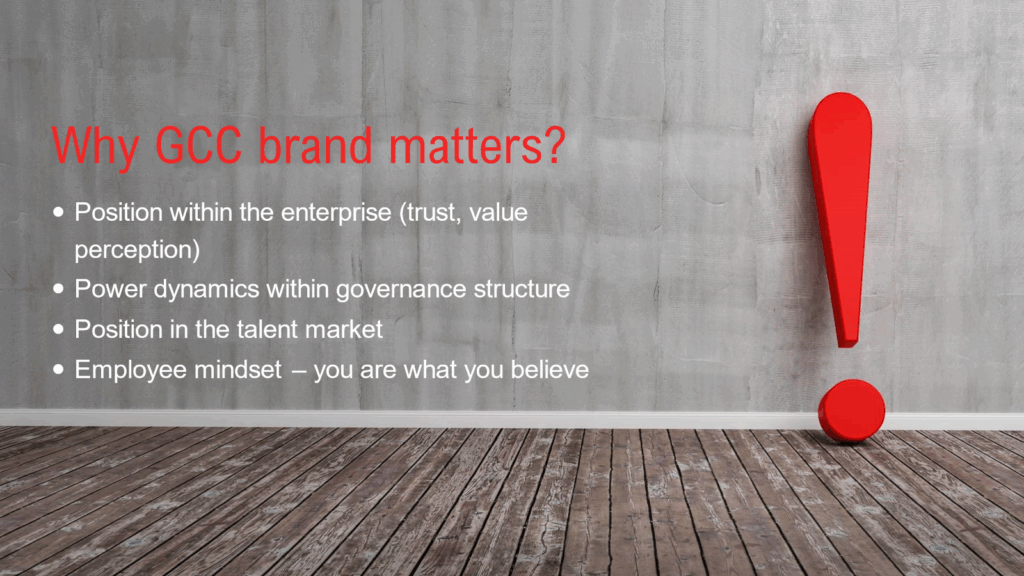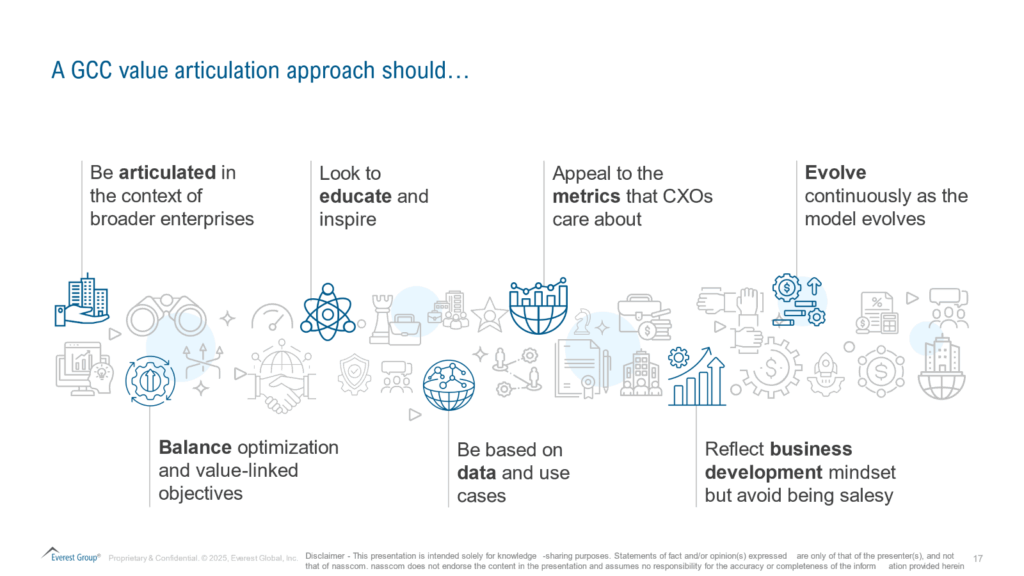Blog
Why GCC Brand Perception Matters – And What You Can Do About It

Over the years, Global Capability Centers (GCCs) have come a long way both in terms of their purpose and perception. What began as a model primarily focused on cost efficiency, often dubbed “captives” or “GICs”, has matured into a value-generating, innovation-driving strategic hub for global enterprises. Yet, on this journey from being a back-office support unit to core contributor, one crucial factor is often overlooked: brand perception.
Reach out to discuss this topic in depth.

GCC’s brand is not just about nomenclature or mere semantics. It’s the sum of how your stakeholders, both internal and external perceive your role, relevance, and potential. And in today’s hyper-competitive and talent-driven landscape, that perception can shape everything from your influence in enterprise decisions to your ability to attract top talent.
Why does it matter more today than ever?
The evolving role of GCCs, combined with rising expectations from enterprise leadership, talent, and markets, makes brand perception not just important, but mission critical.
Here’s the paradox many GCC leaders are living with today:
“We know we’re adding value—but the enterprise doesn’t always see it.”
Most GCC leaders genuinely believe their centers contribute meaningfully to CXO-level priorities. And many do. But this value is rarely quantified and often validated only through informal feedback or stakeholder sentiment. As a result, much of the value gets lost in translation. And that’s why brand perception matters now more than ever.
1) The growing misalignment between value and perception
Despite increasing strategic alignment with enterprise objectives, many GCCs find themselves stuck in an outdated back-office perception trap. While GCC leaders often believe they are contributing meaningfully to CEO priorities such as innovation, customer experience, or agility, these contributions are not always recognized, or even understood, by enterprise stakeholders.
This disconnect arises because GCC value is often articulated in operational terms, such as cost savings, delivery metrics and process efficiency, while enterprise leadership is seeking impact aligned to growth, resilience, and customer-centricity.
2) Brand is more than a name, but the name still matters
One of the most visible manifestations of brand intent is the name you choose for your center. Whether you call it a Global Business Service (GBS), Global In House Centers (GIC), GCC, or use an independent brand identity, the nomenclature sends a strong signal about the strategic purpose of the entity. Increasingly, progressive organizations are dropping legacy labels altogether, positioning their centers as “Second Head Quarters (HQs)” or enterprise innovation hubs, deliberately designed to reflect integration, capability, and leadership.
When naming or renaming your GCC, consider the 5Cs:
Clarity, Continuity, Consistency, Credibility, and Cultural Sensitivity. These elements anchor the brand in both organizational alignment and local resonance.
3) A value proposition that reflects maturity
It’s important for every GCC leader to ask: Are we projecting our true value proposition? Not just internally, but to talent markets, peer networks, and even our own teams?

Brand perception should mirror the true maturity and capability of your GCC. In Everest Group’s maturity diagnostic framework, high-performing GCCs consistently deliver across multiple dimensions:
-
- Business agility
- Operational efficiency
- Customer Centricity
- Cost optimization
- Competitive differentiation
Yet, even as GCCs expand into experience management, artificial intelligence (AI)-driven transformation, and digital product ownership, their value is often under-communicated or misrepresented internally. A strong brand communication can close this gap, turning stakeholder sentiment into measurable strategic influence. But that shift must be reflected in how we speak about ourselves, both internally and externally.
4) Talent is the ultimate stakeholder
Perhaps the most overlooked dimension of brand perception is – talent. In an environment where the war for digital talent is intensifying, a GCC’s external reputation can make or break its ability to attract, engage, and retain the best minds.
Everest Group’s Top GBS Employers™ 2025 report reveals fascinating insights. Brand perception is not solely a function of company size or age. Factors like process ownership, industry vertical, location of headquarters, and Employee Value Proposition (EVP) strength play outsized roles.
While the report revealed several fascinating insights on talent perceptions across industries and regions. A few insights stood out:
-
- Strong employer brands are more correlated with process ownership than size
- EVP clarity drives better engagement and lower attrition
- The origin of the parent company does impact local talent sentiment, but it’s not deterministic
-
- The value gap: real vs. recognized
Many of us leading or closely working with GCCs know the value they bring: driving digital transformation, enabling global growth, building specialized talent pools, and improving enterprise resilience. But here’s the catch, not everyone sees what we see.
There’s a persistent gap between how GCC leaders perceive their contribution and how that contribution is recognized by enterprise stakeholders. We talk in terms of agility, innovation, and customer experience; but often, we’re still being evaluated in terms of cost, efficiency, and headcount.
So, where does this misalignment stem from? In my experience, it often comes down to three critical gaps:
-
- Quantifying the value: Many GCCs still rely on anecdotal stakeholder feedback. What’s needed is a shift to tangible, quantifiable impact aligned with enterprise-level metrics, customer growth, revenue influence, competitive differentiation
- Crafting a clear narrative: Too often, GCCs talk about operational success, but fail to consistently articulate their role in enabling business outcomes, in a language that resonates with CXOs and enterprise leadership
- Elevating the talent experience: The external talent market is often the first lens through which your brand is judged. Yet, employer branding is rarely treated as strategically as delivery excellence. That mismatch affects attraction, engagement, and long-term brand equity
So, what can GCCs do to close the perception gap?
Your GCC’s brand is being shaped every day, through what you say, what you do, and how others experience you. In a world where value is increasingly intangible, perception becomes reality.
Addressing the brand perception challenge isn’t just about a rebrand or a single communication campaign either, it’s about rethinking how you show up across your enterprise and in the talent market. Here are five things every GCC leader should consider:
-
- Revisit your narrative – Does your internal messaging reflect your evolved role?
- Engage stakeholders deliberately – Regularly pulse-check how enterprise leaders perceive your impact
- Tell your talent story – Showcase employee success, culture, and purpose with authenticity
- Define your identity – Be thoughtful about naming and branding. It sets the tone
- Track perception like a KPI – What gets measured gets improved
If this topic resonates with you or your organization is actively evolving its GCC strategy, I invite you to connect with our analyst team for a deeper discussion.
If you found this blog interesting, check out our Beyond The Hype: Unpacking The Risks Associated With Global Capability Centers (GCCs) | Blog – Everest Group, which delves deeper into another topic regarding GCCs.
To continue this discussion or for questions, reach out to Aamir Khan at [email protected] or Rohitashwa Aggarwal at [email protected]
Also, don’t miss our latest Top GBS Employers™ 2025 – Executive Overview, which uncovers how best-in class GCCs are shaping their employer brands in India and beyond.